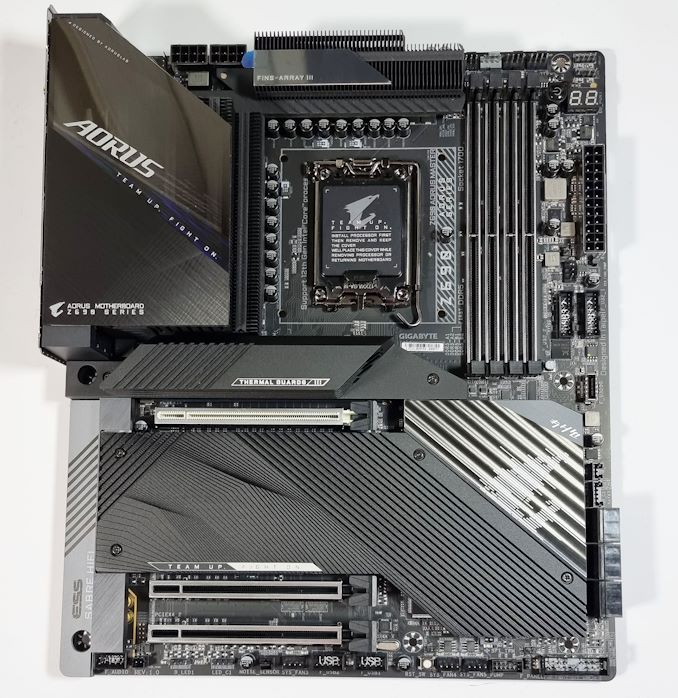The Intel Z690 Motherboard Overview (DDR5): Over 50+ New Models
by Gavin Bonshor on November 9, 2021 9:00 AM ESTGIGABYTE Z690 Aorus Master (DDR5)
Moving down the Aorus series is the GIGABYTE Z690 Aorus Master, which combines a very premium feature set, with the typical Aorus gaming-focused aesthetic we've seen from GIGABYTE over the last couple of years. Focusing on the aesthetic, GIGABYTE is using a primarily black theme with contrasting shades of black and grey throughout, with a brushed aluminum-styled rear panel cover. There are two main areas of integrated RGB LED lighting which include the rear panel cover behind the Aorus logo, as well as within the chipset heatsink. GIGABYTE is advertising a direct 19-phase power delivery with the latest 105 A power stages which screams high end.
Looking at PCIe support, the GIGABYTE Z690 Aorus Master includes one full-length PCIe 5.0 x16 slot, with two full-length PCIe 3.0 x4 slots. Located around the PCIe slot area is a total of five M.2 slots, with four of these operating at PCIe 4.0 x4 M.2, and one PCIe 3.0 x4 M.2 slot. Other storage options include six SATA ports with all featuring support for Intel RAID 0, 1, 5, and 10 arrays. Located in the top right-hand corner is a bank of four memory slots, with support for DDR5-6400, with a maximum capacity of up to 128 GB.
On the rear panel of the GIGABYTE Z690 Aorus Master are two USB 3.2 G2x2 Type-C ports, five USB 3.2 G2 Type-A, and four USB 3.2 G1 Type-A ports. GIGABYTE does include one DisplayPort 1.4 video output for users looking to utilize Intel's integrated graphics, while five 3.5 mm audio jacks and S/PDIF optical output are powered by a Realtek ALC1220 HD audio codec and ESS Sabre 9118EQ amplifier pairing. Networking is impressive with a single Aquantia AQC107 10 GbE controller and Intel AX211 Wi-Fi 6E CNVi pairing. Finishing off the rear panel is a clear CMOS button and Q-Flash BIOS Flashback button.












126 Comments
View All Comments
Dahak - Tuesday, November 9, 2021 - link
Will there be a list of DDR4 only board as well?Ryan Smith - Wednesday, November 10, 2021 - link
Yes, we're also putting together a guide for DDR4 boards.jh20001 - Wednesday, December 1, 2021 - link
Any news on the DDR4 story? Would be nice to know what model is the best for performance/features in the eyes of others.Flunk - Tuesday, November 9, 2021 - link
Intel's actually released a compelling new chipset? I'm surprised to see DDR5 and PCIe 5 support, but USB 4 seems to be notably absent, despite there being no reason at all to omit it. Intel is finally one-upping AMD after a few years of playing #2.Exotica - Tuesday, November 9, 2021 - link
Thunderbolt4 is usb4 capable…CharonPDX - Tuesday, November 9, 2021 - link
Yep, the only thing USB4 adds over "USB 3.2 2x2" is Thunderbolt support. Therefore any Thunderbolt 4 device is automatically USB4. In fact, essentially any board with "Thunderbolt 3" along with USB 3.2 2x2 basically get "USB4" status for free.DigitalFreak - Tuesday, November 9, 2021 - link
USB 3.2 2x2 is 20 Gbps. USB 4 is 40 Gbps.12345 - Wednesday, November 10, 2021 - link
That's why they mentioned TB3. 40Gbps support is also optional for USB4.12345 - Wednesday, November 10, 2021 - link
DP 2.0 is mandatory for USB4 so TB3 support isn't good enough.KarlKastor - Wednesday, November 10, 2021 - link
That is only the name. The question is, with what speed you can run USB devices.